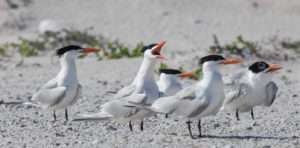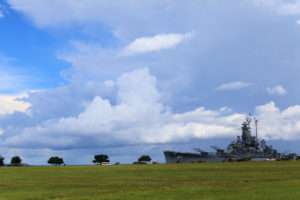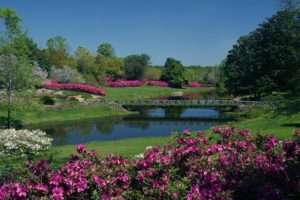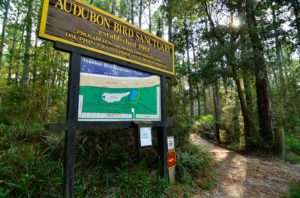Dauphin Island’s shell mound is actually two major features – a large shell ridge to the north and a partial shell ring to the south. A small stream fed by a nearby freshwater spring originally flowed through the area between the features and served as an important drinking water source. As a barrier island, Dauphin Island is part of a complex estuarine environment that includes sand beaches, tidal marshes, and shallow lagoons that are rich in sea life. The abundance of food, fresh water, and other essential resources in the immediate area made this location a popular seasonal settlement for indigenous peoples over thousands of years.
In 1975, archaeologists from The University of Alabama conducted excavations at this site and identified evidence of a long sequence of prehistoric settlements that range from the Bayou La Batre-Tchefuncte culture of the Gulf Formational Stage approximately 4500 to 3200 years ago, to the Fort Walton and Pensacola phase of the Mississippian Stage around 900 to 500 years ago, to the first written records of the Mobile tribe that occupied the area at the time of European contact. The Spanish explorer Alonso Álvarez de Piñeda sailed the eastern portion of the Gulf Coast in 1519, and likely visited Mobile Bay and the Alabama River. During his journey, Piñeda noted numerous villages and settlements along the shoreline and he may have been the first European to see the Dauphin Island Shell Mounds.
Shell ring mounds such as the one located here are scattered along the Atlantic and Gulf Coasts. They likely represent gathering sites where people came together at various times of the year to harvest fish, shellfish, and marine birds and other animals, to feast together, and exchange goods and ideas. Their layout and artifact distribution often shows evidence of social structure with important individuals such as religious and political leaders occupying houses at the highest point and opposite the main entrance to the ring and surrounded by the houses of other lesser leaders and prominent warriors.
This site is very important to numerous Southeastern indigenous tribes who assert an ancestral connection with those who built and occupied Alabama’s ancient mounds. The prehistoric earthworks and the objects and information recovered from them reveal a rich cultural tradition that still thrives today among these tribes. Our indigenous mound sites represent a heritage for all Alabamians to cherish, and it is important that we protect and preserve them for future generations.
Located in Mobile County.

Alabama Coastal Birding Trail
Alabama’s Gulf Coast is a paradise not only for birders, but for visitors with many different outdoor interests. The Coastal Birding Trail features si

Battleship Park
From its humble beginnings on February 1, 1940 as the keel was laid at the Norfolk Navy Yard in Portsmouth, Virginia, Battleship USS ALABAMA (BB-60) h

Bellingrath Gardens
Bellingrath Gardens is a former fish camp on the banks of the Fowl River whose owners, Walter and Bessie Bellingrath, converted to a garden with both

Dauphin Island Bird Sanctuary
The sanctuary consists of 164 acres of largely maritime pine forest with several miles of trails. Passerines prefer the oak grove of the old Banding A

You must be logged in to post a comment.